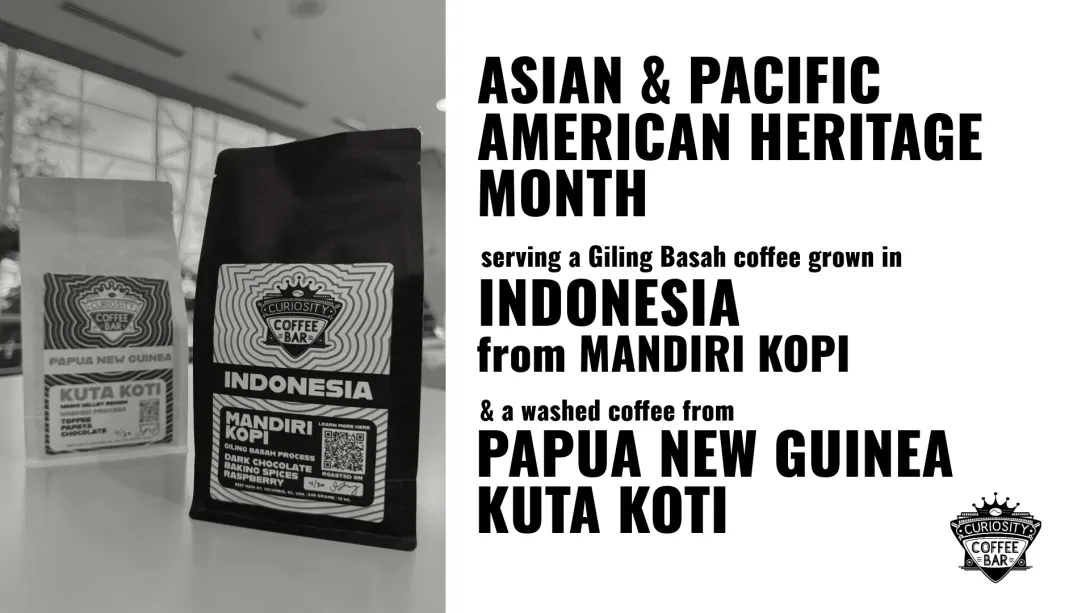
For the month of May we are featuring coffees from Papua New Guinea and Indonesia. Centuries of trade, colonization, and tradition have shaped some of the most distinct coffees in the world. In Indonesia, coffee was first planted by the Dutch in the 1600s, eventually giving rise to the legendary earthy, full-bodied profiles of Sumatra and Java. Just to the east, coffee came to Papua New Guinea in the late 19th century, often grown in small village plots in rich volcanic soil, producing vibrant, fruity, and complex cups. From the misty highlands of the Upper Waghi Valley to the rugged plantations of Sulawesi, this region carries a raw, hands-on spirit that still defines how much of the coffee is grown and processed today.
INDONESIA
One unique aspect to Indonesian coffee is the Giling Basah process. Coffee beans are hulled while they’re still pretty wet — around 30–40% moisture — which helps create a rich, earthy flavor and a heavy, smooth body.
MANDIRI KOPI
Mandiri Kopi places a strong emphasis on traceability, sustainability, and delivering top-notch coffees. Their approach is grounded in ethical farming practices,
guaranteeing competitive prices and a dependable supply chain. They foster mutually beneficial partnerships with their suppliers, providing support to farmers and distributors alike.
But their commitment goes beyond just coffee—it's a dedication to shaping the future. They're invested in the education and housing of their employees, actively
contributing to social and environmental development within the community. Their vision is to thrive as a competitive industry, and their mission is all about enhancing the well-being of everyone involved.
Mandiri was established in 2011 by the Ministry of Cooperatives and has since grown to a membership of 1,400. In their pursuit of quality, they employ inventive teaching and consulting strategies to help producers achieve higher standards. They also share their expertise on the use of organic fertilizers among their producers.
BOOK PAIRINGS
This Earth of Mankind (Bumi Manusia)
This Earth of Mankind is a powerful historical novel that serves as the first installment of the Buru Quartet, written by Indonesian author Pramoedya Ananta Toer. Set in the late 19th and early 20th centuries during the Dutch colonial period in Indonesia, the novel explores themes of colonialism, identity, and social justice.
The Rainbow Troops (Laskar Pelangi)
The Rainbow Troops is a heartwarming novel by Indonesian author Andrea Hirata, set in the small village of Gantong on the island of Belitung. The story follows a group of impoverished but determined schoolchildren who strive for education in the face of adversity.
PAPUA NEW GUINEA
Coffee came to Papua New Guinea in the late 19th century - but the first major coffee plantings began in the 1920s, with seeds imported directly from Jamaica’s famed Blue Mountains. Today, about 95% of Papua New Guinea’s coffee is grown by smallholder farmers — often on family plots with fewer than 60 trees.
KUTA KOFI
The Kuta Papua New Guinea is sourced from smallholder farmers in the Upper Waghi Valley. The region has black volcanic loamy soil and a climate favorable for growing quality coffee. The valley receives approximately 1,800-2,000 mm of rainfall per year with a dry season from April to August.
The coffee is processed at the Kuta Kofi mill. Smallholder farmers from Ambra, Kelewa, and Wurup bring cherry to the Kuta mill for purchase. The cherries are sorted and de-pulped before being fermented in vats for 36 hours. The coffee is washed 3 times and then brought to large sun-drying fields. The coffee is fully sun-dried on tarpaulins for 3 to 4 hours daily for a period of 5 to 10 days depending on weather conditions. The dry parchment is taken to the dry mill and placed in wooden conditioning bins where it is allowed to rest for 2 to 3 weeks prior to hulling.
BOOK PAIRINGS
Maiba, A Papuan Novel
Maiba, A Papuan Novel by Russell Soaba follows the life of Maiba, a young man navigating the challenges of traditional life and modern influences in Papua New Guinea. Through his journey, readers gain insight into the rich cultural heritage of the region, as well as the conflicts that arise from the encroachment of Western values and globalization.
